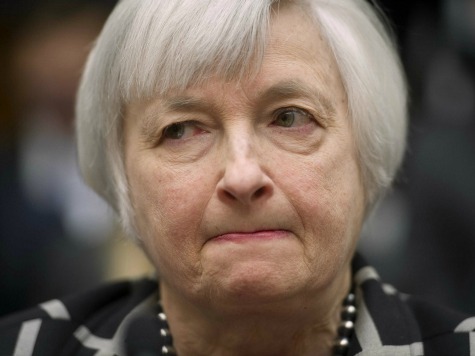Federal Reserve Chair Janet Yellen mentioned “labor market” 47 times in her speech, entitled “Labor Market Dynamics and Monetary Policy,” which she delivered at the annual Jackson Hole Conference. Ms. Yellen and the Fed’s Open Market Committee that controls the U.S. money supply are now relying on changes in the demand for productive labor to set interest rates.
According to Ms. Yellen:
One convenient way to summarize the information contained in a large number of indicators is through the use of so-called factor models. Following this methodology, Federal Reserve Board staff developed a labor market conditions index from 19 labor market indicators, including four I just discussed. This broadly based metric supports the conclusion that the labor market has improved significantly over the past year, but it also suggests that the decline in the unemployment rate over this period somewhat overstates the improvement in overall labor market conditions.
This change in attitude by the Federal Reserve is grim news for consumption-side economists who believe that the American economy exists to fill shopping malls with credit card wielding consumers. But it is great for news for supply-side economists that believe the American economy exists to be more competitive, produce more products and services, and create high paying jobs.
The “Labor Market Conditions Index” is a fairly new econometric model that includes 19 elements of the economy including rates of hiring and resignations in the Labor Department’s Job Openings and Labor Turnover Survey (JOLTS); two indicators of the length of the workweek; three calculations of employment levels for private, government, and temporary help payrolls; and survey data from the Conference Board’s index of jobs plentiful versus hard-to-get index and employer hiring plans from the National Federation of Independent Business.
Economists often refer to Gross Domestic Product. But GDP doesn’t measure any production; it was invented by Lord John Maynard Keynes to measures consumption. Keynes’ theories turned reality on its head.
In the real world, something must be produced and then consumed. Traditional economics before Keynes called this fundamental requirement “Say’s Law.” But Keynes said that producers are only “stimulated” to produce when there is an immediate demand for consumption. Keynesian economics demands consumption before produce. In this fantasy land, measurement of production, GDP, really is a measure of Gross Domestic Consumption.
In Keynes consumption-side world, the price someone would pay for a product is established by his ability to pay the price. This money burning a hole in the pocket theory assumes consumers should spend savings and credit available before prices inflate.
In the supply-side world, the price someone is willing to pay for a product is determined by the price of the product. This is called elasticity because the more availability of a product, the lower the price and greater volume of product will be sold. In the supply-side world, savings and investment are encouraged because there is an expectation of more production in the future, and the product will then be selling at a cheaper price.
Looking at the Business Insider review of the LMCI, calculated by UBS Bank’s Drew Matus, the index is already 20% above the level in 1994 and 2005, and the Fed began tightening the money supply to raise interest rates and prevent an outbreak in inflation. Matus notes that in the 2008-2009 recession, the “LMCI fall was unusually steep.”
This unusually deep plunge in the index and the failed Keynesian stimulus policies aimed exclusively at more consumption, rather than production, probably explains why LMCI has recovered, but worker’s average hourly earnings and labor force participation have rebounded only about a third as fast.
Higher interest rates in the Keynesian world are a disaster because borrowing to consume is more expensive. In the real world, higher interest rates prevent inflation and encourage more saving and investment. As Chair Yellen warned in her Jackson Hole speech, she is focused on the rising LMCI and ready to rapidly raise interest rates if inflation breaks out:
“If progress in the labor market continues to be more rapid than anticipated by the Committee or if inflation moves up more rapidly than anticipated, resulting in faster convergence toward our dual objectives, then increases in the federal funds rate target could come sooner than the Committee currently expects and could be more rapid thereafter.”
For more insights from Chriss Street on the failure of Keynesian economics,
please click on Real Household Incomes Fall 5.9% under Obama.

COMMENTS
Please let us know if you're having issues with commenting.